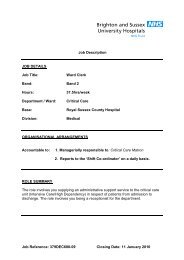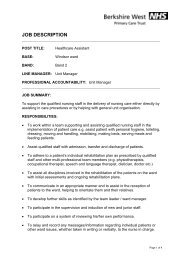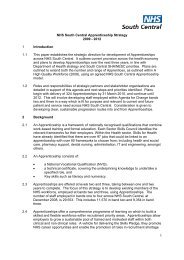Liberating the NHS: Developing the Healthcare Workforce ...
Liberating the NHS: Developing the Healthcare Workforce ...
Liberating the NHS: Developing the Healthcare Workforce ...
Create successful ePaper yourself
Turn your PDF publications into a flip-book with our unique Google optimized e-Paper software.
Q29: What should be <strong>the</strong> scope for central investment through <strong>the</strong> Multi-Professional Education and Training budget? Firstly, need clarity around <strong>the</strong> terms “next generation of clinical staff” eg does thisinclude trainee doctors, or are <strong>the</strong>se people part of <strong>the</strong> current workforce engaged inservice delivery Initiatives that contribute towards a managed workforce market Commissioning and development of smaller professional groups National policy initiatives, eg current increase in health visitors must be fundednationally or left to local providers to determine need There is a case for central investment in areas which underpin education andworkforce development to deliver best value for money and avoid duplication Need to ensure close working with HEIs as many education providers are currentlyreviewing <strong>the</strong>ir own programmes and as a result <strong>the</strong>re may be cases for joined upapproaches by Skills Network or direct central investment.Q30: How can we ensure funding streams do not act as a disincentive to innovationand are able to support changes in skill mix? Ring- fenced funding for education and training, but flexibility within that Funding streams for care pathways with local skills networks to determine <strong>the</strong> skillsgaps along those pathways Remit for skills networks to deliver innovation in workforce and education and build<strong>the</strong> evidence-base Longer-term commitment to funding – at least three years or fund commissionoutcomes ra<strong>the</strong>r than inputs.Q31: How can we manage <strong>the</strong> transition to tariffs for clinical education and training ina way that provides stability, is fair and minimises <strong>the</strong> risks to providers? Retain <strong>the</strong> current MPET funding streams for two to three years to fund <strong>the</strong> newarrangements and ensure focus on delivery of healthcare workforce development Transition to tariffs to be assessed alongside <strong>the</strong> impact of o<strong>the</strong>r changes in financeand not in isolation in order to determine <strong>the</strong> issues and plan transition Long lead times have been previously discussed – phased in over four years Too much change too soon will seriously destabilise large providers with minimalbenefit to organisations set to gain. Let <strong>the</strong> new systems bed in before fur<strong>the</strong>r change Clarity needed around <strong>the</strong> negotiation of <strong>the</strong> benchmark price and how HEE will beperformance managed to undertake this task This must apply to all sectors.Q32: If tariffs are introduced, should <strong>the</strong> determination of <strong>the</strong> costs and tariffs foreducation and training be part of <strong>the</strong> same framework as service tariffs? Possibly, but need to know if <strong>the</strong>re is a presumed element of education and trainingin service tariffs already in existence Education and training tariffs should be clearly set out separately from service tariffsand would <strong>the</strong>n need to include recognition of education and training <strong>the</strong> wholeworkforce.South Central Strategic Health Authority – DHW Consultation Response 12
















